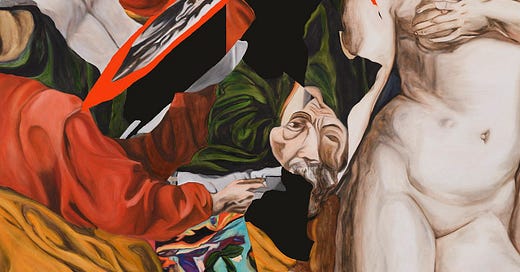Curated by: Giuliana Benassi, Michela Sena
25 March - 25 April
Opening Reception: Saturday, 25 March at 4:00 PM
Will the image survive the future? Walking through Alessandro Giannì's works conceived for his solo exhibition at Tang Contemporary Art in Bangkok, this question arises like a distant echo, a faint voice that resurfaces as if fixed in time, as if asked by a past that is still alive. Of this still-living past, the first to give trace of it are the subjects Giannì portrays: excerpts of subjects from Renaissance paintings live on and merge into utterly new forms and vivid, contemporary colors. They are recognizable and at the same time unrecognizable, familiar subjects and at the same time undefinable. They stand out against vivid backgrounds or seem to merge into multicolored cascades. They are parts of bygone works that in Giannì's canvases have lost their author, although endlessly quoting him.
In this whirlwind of images, the artist perhaps finds the opening to break into obscurity. However, he does so by making use of a collaboration with an unusual assistant, namely "Vasari," an artificial intelligence designed by the artist himself and which helps produce the compositional part of the image. This AI is created specifically by the artist and is capable of digitally emulating his way of composing images before they become paintings. In this sense, the AI operates as a Renaissance assistant, able to digitally process visual compositions as the artist imagines them.
The AI was named after Giorgio Vasari with intent - the first and greatest biographer of visual artists, who narrated the lives of the most illustrious painters, sculptors, and architects from 1200 to 1500 in Florence, encapsulating them all in a time. In Giannì's hands, this great time feels as if it has been shaken, its contents blended, pulled out after centuries, and tossed, only to be fished out of the great digital magma.
And it is in this momentum toward a hypothetical future of Artificial Intelligence we return to painting, to the necessity of the pictorial gesture.
Giannì's works are therefore the testimony of the image of its becoming in time and space. The pictorial surface carries with it the memory of the original works and their digital passage. The two aspects mix, until they produce a new image, a new scenario where light bursts in revealing vibrant colors.
Taking us back to answering the question posed at the beginning, Giannì seems to narrate a world that has survived a hypothetical apocalypse where images remain, suspended in time, divided, or rediscovered with only the memory of themselves.
in case you’ve missed…




